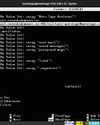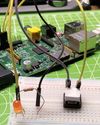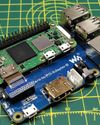Do you CVE What I CVE?
Linux Format
|September 2019
Wind River Systems’ David Reyna talks to Jonni Bidwell about keeping the embedded space safe – and also fixing robots on Mars.

David Reyna, one of the Senior Technical Staff at Wind River Systems, is a veteran of the embedded computing world, with over 20 years of experience. He’s involved with Yocto Project (see tutorials LXF251) and develops workflow and optimisation tools for Linux. His work began with digital radiography and most recently involves management tools for software vulnerabilities.
Wind River is a leader in the embedded space, being one of few companies that can claim its code is running on Mars. David gave a talk on this at the Linux Foundation’s Embedded Linux Conference in Edinburgh in October 2018, and was good enough to take the time to share some of his wisdom with our own suspected Martianin-residence.
Linux Format: Wind River has been around for a long time – almost as long as I have, in fact (blimey – Ed). Could you tell us a bit about the early days of the company, and how your real-time OS (RTOS) called VxWorks came about?
David Reyna: Yep, we’ve been around since the ’80s. We were embedded since before embedded was a thing. We were in IoT before IoT was a thing.
I should say that I wasn’t around in the early days – I joined Wind River in 2000. But I know some of the history, so here goes… Wind River started at UC Berkeley, back when people were just starting with embedded systems. There were a few other companies doing similar work – Vertex was one of them and there were a couple of other small ones. The difficulty was that there was no operating system for embedded devices.
So Wind River decided to move into that industry and provide an OS with some key features. The main one was [being] real-time, that was a real distinguishing factor. It didn’t just need to run, it needed to have response, provability, latency, all those kind of things.
このストーリーは、Linux Format の September 2019 版からのものです。
Magzter GOLD を購読すると、厳選された何千ものプレミアム記事や、10,000 以上の雑誌や新聞にアクセスできます。
すでに購読者ですか? サインイン
Linux Format からのその他のストーリー

Linux Format
Create your first WebSocket service
Mihalis Tsoukalos explains how to use the Go programming language to work with the WebSocket protocol.
9 mins
April 2023

Linux Format
Fantastic Mr Firefox
Nick Peers takes a trip down memory lane to reveal the story behind the rise - and slight fall - of Mozilla's popular web browser.
9 mins
April 2023

Linux Format
Set up your terminal and email like it's 1983
Jump in the hot terminal time machine with Mats Tage Axelsson who emails from the command line using the latest technology.
8 mins
April 2023

Linux Format
Universal layer text effects with GIMP
Posters use them, films and presentations are hard to imagine without them: text effects. Attract attention with Karsten Günther and GIMP.
8 mins
April 2023

Linux Format
Jump to a federated social network
Nick Peers reveals how you can get up and running with this free, decentralised and non-profit alternative to Twitter.
9 mins
April 2023

Linux Format
Free our SOFTWARE!
Taking anything for granted is dangerous, so Jonni Bidwell and Mike Saunders revisit how the free software movement got started to help free us from proprietary tyranny!
4 mins
April 2023

Linux Format
Master RPI.GPIO
Les Pounder goes back to the early days of the Raspberry Pi - and his career with this classic library! -
5 mins
April 2023

Linux Format
Waveshare Zero to Pi3
Transform your Pi Zero into a Pi 3, they promised Les Pounder, but it's more like adding on go-faster stripes.
2 mins
April 2023

Linux Format
The Best OPEN SOURCE Software Ever!
In an attempt to trigger controversy, Michael Reed and Neil Mohr unequivocally state these are the greatest free software apps ever. Probably. We’re just trying to be helpful.
19 mins
April 2023

Linux Format
Linux-Mandrake 7
Simplicity and a wide range of applications make this a great distribution for all Linux users.
2 mins
April 2023
Translate
Change font size

